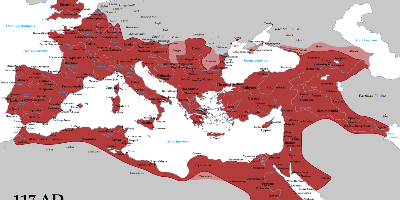Fourth Dictatorship of Gaius Julius Caesar (1 janv. 44 av. J.-C. – 31 déc. 44 av. J.-C.)
Description:
When Caesar returned to Rome, the Senate granted him triumphs for his victories, ostensibly those over Gaul, Egypt, Pharnaces, and Juba, rather than over his Roman opponents. When Arsinoe IV, Egypt's former queen, was paraded in chains, the spectators admired her dignified bearing and were moved to pity. Triumphal games were held, with beast-hunts involving 400 lions, and gladiator contests. A naval battle was held on a flooded basin at the Field of Mars. At the Circus Maximus, two armies of war captives, each of 2,000 people, 200 horses, and 20 elephants, fought to the death. Again, some bystanders complained, this time at Caesar's wasteful extravagance. A riot broke out, and only stopped when Caesar had two rioters sacrificed by the priests on the Field of Mars.After the triumph, Caesar set out to pass an ambitious legislative agenda. He ordered a census be taken, which forced a reduction in the grain dole, and decreed that jurors could only come from the Senate or the equestrian ranks. He passed a sumptuary law that restricted the purchase of certain luxuries. After this, he passed a law that rewarded families for having many children, to speed up the repopulation of Italy. Then, he outlawed professional guilds, except those of ancient foundation, since many of these were subversive political clubs. He then passed a term-limit law applicable to governors. He passed a debt-restructuring law, which ultimately eliminated about a fourth of all debts owed.
The Forum of Caesar, with its Temple of Venus Genetrix, was then built, among many other public works. Caesar also tightly regulated the purchase of state-subsidized grain and reduced the number of recipients to a fixed number, all of whom were entered into a special register. From 47 to 44 BC, he made plans for the distribution of land to about 15,000 of his veterans.
The most important change, however, was his reform of the calendar. The Roman calendar at the time was regulated by the movement of the moon. By replacing it with the Egyptian calendar, based on the sun, Roman farmers were able to use it as the basis of consistent seasonal planting from year to year. He set the length of the year to 365.25 days by adding an intercalary/leap day at the end of February every fourth year.
To bring the calendar into alignment with the seasons, he decreed that three extra months be inserted into 46 BC (the ordinary intercalary month at the end of February, and two extra months after November). Thus, the Julian calendar opened on 1 January 45 BC. This calendar is almost identical to the current Western calendar.
Shortly before his assassination, he passed a few more reforms. He established a police force, appointed officials to carry out his land reforms, and ordered the rebuilding of Carthage and Corinth. He also extended Latin rights throughout the Roman world, and then abolished the tax system and reverted to the earlier version that allowed cities to collect tribute however they wanted, rather than needing Roman intermediaries. His assassination prevented further and larger schemes, which included the construction of an unprecedented temple to Mars, a huge theater, and a library on the scale of the Library of Alexandria.
He also wanted to convert Ostia to a major port, and cut a canal through the Isthmus of Corinth. Militarily, he wanted to conquer the Dacians and Parthians, and avenge the loss at Carrhae. Thus, he instituted a massive mobilization. Shortly before his assassination, the Senate named him censor for life and Father of the Fatherland, and the month of Quintilis was renamed July in his honor.
He was granted further honors, which were later used to justify his assassination as a would-be divine monarch: coins were issued bearing his image and his statue was placed next to those of the kings. He was granted a golden chair in the Senate, was allowed to wear triumphal dress whenever he chose, and was offered a form of semi-official or popular cult, with Mark Antony as his high priest.
Ajouté au bande de temps:
Date:
1 janv. 44 av. J.-C.
31 déc. 44 av. J.-C.
~ 12 months
